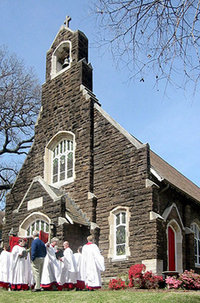St Andrew's Episcopal Church: Difference between revisions
m (→External links) |
|||
| Line 3: | Line 3: | ||
==History== | ==History== | ||
St Andrews started out around 1910 as a Sunday School mission from the Advent. Led by members of the brotherhood of St Andrew, the mission asked for permission to become a parish church, which was granted. Shortly after, a tornado destroyed the frame building, down the street at 1008 11th Avenue South, during Holy Week. After considering a merger with [[St Mary's on the Highlands Episcopal Church]], the parish decided to remain separate and to rebuild. | St Andrews started out around 1910 as a Sunday School mission from the [{Episcopal Church of the Advent]]. Led by members of the brotherhood of St Andrew, the mission asked for permission to become a parish church, which was granted. Shortly after, a tornado destroyed the frame building, down the street at 1008 11th Avenue South, during Holy Week. After considering a merger with [[St Mary's on the Highlands Episcopal Church]], the parish decided to remain separate and to rebuild. | ||
The current church building, was constructed in [[1913]] in the English gothic style using rough-faced brownstone with limestone trim. The design was by J. M. Marriott, of the firm of Joy-Marriott, which also constructed the building. The church bell is located in a raised gable above the narthex. The bright-red arched wooden doors have been a Southside landmark for generations. | The current church building, was constructed in [[1913]] in the English gothic style using rough-faced brownstone with limestone trim. The design was by J. M. Marriott, of the firm of Joy-Marriott, which also constructed the building. The church bell is located in a raised gable above the narthex. The bright-red arched wooden doors have been a Southside landmark for generations. | ||
Revision as of 14:02, 8 June 2006
St Andrew's Episcopal Church is a parish church located on the northwest corner of 11th Avenue South and 12th Street on Birmingham's Southside. The rector is Rev. Marc Burnette and the liturgy is "high church". In addition to regular Sunday services, the church operates a preschool program and a residence for the mentally handicapped.
History
St Andrews started out around 1910 as a Sunday School mission from the [{Episcopal Church of the Advent]]. Led by members of the brotherhood of St Andrew, the mission asked for permission to become a parish church, which was granted. Shortly after, a tornado destroyed the frame building, down the street at 1008 11th Avenue South, during Holy Week. After considering a merger with St Mary's on the Highlands Episcopal Church, the parish decided to remain separate and to rebuild.
The current church building, was constructed in 1913 in the English gothic style using rough-faced brownstone with limestone trim. The design was by J. M. Marriott, of the firm of Joy-Marriott, which also constructed the building. The church bell is located in a raised gable above the narthex. The bright-red arched wooden doors have been a Southside landmark for generations.
A 1980s addition to the back of the church added offices, classrooms, meeting rooms, and a parish hall. Community Kitchens and other non-profits have their offices in the building. In the early 21st century the church underwent a multi-phase renovation which included rebuilding failed retaining walls at the perimeter of the lot, re-roofing the church and parish hall (in slate and copper, respectively), adding a new pipe organ to the nave, refurbishing the Lady Chapel, and reconfiguring the choir and chancel. Architectural services were provided by Carraway & Associates and the work was performed by Day Star Construction.
In 2006 work began on a new building for Episcopal Campus Ministries on the rear of the site. This building was designed by Mark Burns and is being constructed by Bradford Building Company.
Adjacent to the church is St Joseph's House, which serves as a meeting place and the sexton's residence.
Trivia
On September 28, 1986, St Andrew's was added to the National Register of Historic Places.
In early 2006 parishioner Mike McKenzie created a short parody of a radio advertisement for St Andrew's in the style of a monster truck rally spot. Though it was never aired on radio, an MP3 file of the spot spread quickly through the Episcopal community provoking laughter, ire and admiration.
References
- Birmingham Historical Society (1981) Southside-Highlands Report: Architectural & Historical Resources, Preservation Recommendations." Birmingham: Birmingham Historical Society.
External links
- St Andrew's Episcopal Church website
